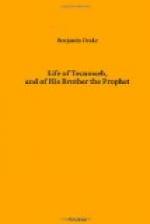orders to his men, and in the mean time, according
to Mr. B., “word ran through the army that he
had killed Tecumseh.” This is more remarkable,
when it is recollected, that the only person, except
the commanding general, who could identify the fallen
chief, was Anthony Shane, and he was in a different
part of the field, (on the bank of the Thames) and
did not visit this part of the line until the action
was entirely over! The witness further states,
that no other chief of high rank was killed in this
part of the line, but Tecumseh. Anthony Shane
says that Tecumseh’s brother-in-law, and principal
chief, Wasegoboah, was killed ten or fifteen steps
from where Tecumseh fell. Black Hawk also testifies,
that near Tecumseh, there was lying a large, fine
looking Potawatamie, decked off in his plumes and war-paint,
whom the Americans mistook for Tecumseh. Mr.
B. says that a medal was taken from the body of the
Indian killed by colonel Johnson, which was known
to have been presented by the British government to
Tecumseh. Where is the authority for this?
When Shane was examining the body, and so much in
doubt whether it was Tecumseh as to require the blood
to be washed from the face, before he could decide
with certainty, where was this medal, which of itself
would have settled the question of identity? It
is singular, that neither Shane nor Wall speaks of
a medal. Mr. B. says that Tecumseh was killed
by a ball and three buckshot, fired by a horseman,
and as colonel Johnson was the only person in that
part of the battle who fought on horseback, his pistols
being loaded with a ball and three buckshot, settles
the question, that the colonel killed Tecumseh.
Again, the question may be asked, how Mr. B. knows
the fact as to the manner in which these pistols were
loaded? And if they were so loaded, who can say
whether the chief was killed by this shot, the wound
in the eyes, that in the neck, or the one in the hip?
But again; colonel Johnson was not the only person
who fought on horseback in this part of the battle.
He led a “forlorn hope” of twenty men,
all mounted; while on his left was Davidson’s
company of one hundred and forty men, also on horseback.
Mr. Wall, who was one of the “forlorn hope,”
says, “the fighting became very severe, each
party mingling with the other.” Finally,
Mr. B. closes his testimony with the remark, that it
was well known and acknowledged, by the British and
Indians, at the time, that Tecumseh received his death
from the hand of colonel Johnson, as appears by James’
History of the Late War. It is stated by the
historian here cited, that colonel Johnson shot Tecumseh
in the head—that the body was recognized
not only by the British officers who were prisoners,
but by commodore Perry and several other American
officers: Mr. James also expresses his surprise
that general Harrison should have omitted, in his
official letter to the War Department, to mention
the death of this chief. Now, we have the authority
of several American officers, of high rank, for stating,




